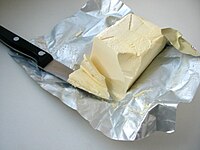
Photo from wikipedia
Preservation of emulsions relies on factors including pH, temperature, structure and the application of carboxylic acid preservatives, such as sorbic and benzoic acid. Organic acid preservatives tend to migrate to… Click to show full abstract
Preservation of emulsions relies on factors including pH, temperature, structure and the application of carboxylic acid preservatives, such as sorbic and benzoic acid. Organic acid preservatives tend to migrate to the lipid phase of emulsions. Taking into account the fact that organic acid in the aqueous phase is solely responsible for antimicrobial activity, this partitioning behavior is considered as a loss of preservative. The influence of microstructure properties on sorbic acid distribution and preservation effect was investigated in model food systems comprising of aqueous phase, and liquid oil and solid fat as lipid phase, which represent major constituents of water-oil emulsions. The aqueous phase of the food model systems was comprised of Yeast Nitrogen Broth (YNB) in phosphate buffer and buffered at pH 4.5, 5.5, 6.5. Sorbic acid (100 mg/L) in the form of potassium sorbate was added to the aqueous phase. Candida guilliermondii (2 log CFU/mL) was inoculated in the aqueous phase to resemble industrial post-contamination CFU levels. Growth parameters, generation time (GT) and lag phase (λ) of C. guilliermondii in the aqueous phase of the food model systems were quantified during 1 month at 7 °C and maximum 80 h at 22 °C. HPLC analyses were performed to evaluate total sorbic acid content in each food model system. Sorbic acid inhibited growth of C. guilliermondii in YNB + SA at pH 4.5 at 7 °C and 22 °C. The presence of liquid oil caused partitioning of sorbic acid into the lipid phase in YNB + SA|oil at pH 4.5 at 7 °C and 22 °C, reducing its inhibitory effect. Adding solid fat into the model food systems significantly prolonged lag phase duration in the YNB + SA|oil + fat system at pH 4.5 at 22 °C and growth was inhibited at 7 °C. HPLC analysis showed a final aqueous sorbic acid concentration of 34 mg/L and 44 mg/L in YNB + SA|oil system at pH 4.5 at 7 °C and 22 °C after 1 month and 168 h, respectively. In YNB + SA|oil + fat system at pH 4.5, 87 mg/L of aqueous sorbic acid was measured after 1 month at 7 °C and 168 h at 22 °C, indicating that the presence of solid fat retards sorbic acid partitioning. Results show that structural components such as liquid oil and solid fat have an effect on the aqueous sorbic acid concentration and its preservation effect. The presence of solid fat reduces the tendency of sorbic acid to partition into the lipid phase, which is reflected in the inhibitory effect of sorbic acid on C. guilliermondii.
Journal Title: International journal of food microbiology
Year Published: 2018
Link to full text (if available)
Share on Social Media: Sign Up to like & get
recommendations!